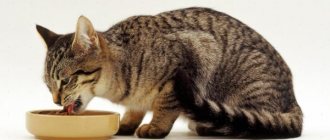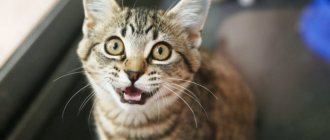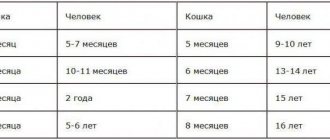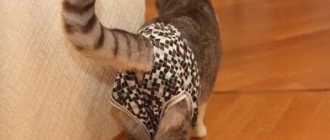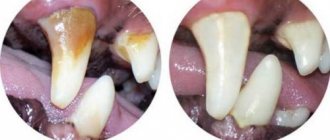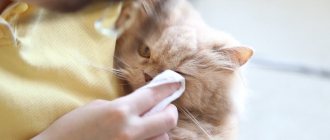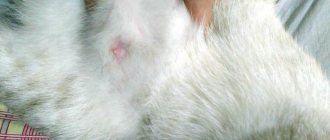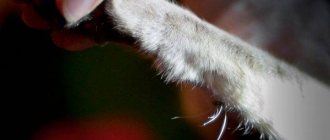Tables of a cat's age by human standards
This technique was developed by zoologists and veterinarians. The basis is a coefficient that takes into account not only the physiological development, but also the psychological and intellectual level of the animal at each stage of life. On this basis, a table has been compiled that allows you to approximately find out the relationship between the age of a cat and human ideas.
Be sure to read the article to the end, in it we will tell you how to accurately compare a cat’s age with a human’s. Let's talk about other ways.
Kittens up to one year:
| Animal age (months) | Similar human age (years) |
| 1 | 0,5 |
| 2 | 1 |
| 3 | 2 |
| 4 | 6 |
| 5 | 10 |
| 6 | 13 |
| 12 | 18 |
Adult cats and female cats:
| Animal age (years) | Similar human age (years) |
| 2 | 25 |
| 3 | 32 |
| 4 | 35 |
| 5 | 40 |
| 6 | 43 |
| 7 | 46 |
| 8 | 50 |
| 9 | 55 |
| 10 | 60 |
| 11 | 64 |
| 12 | 67 |
| 13 | 70 |
| 14 | 72 |
| 15 | 75 |
| 16 | 76 |
| 17 | 78 |
| 18 | 83 |
| 19 | 91 |
| 20 | 100 |
Although this definition is closest to the truth, it must be remembered that it is impossible to accurately compare human and cat ages due to their fundamental differences in development as biological species.
Stages of a cat's life
According to scientists, a cat’s life goes through six age stages:
- Childhood (from birth to 6 months) is a stage of rapid growth and development until the onset of puberty.
- Youth (from 6 months to 2 years) – preparation for adulthood; growth continues, but its pace is decreasing.
- The prime of life (from 2 to 7 years) is the peak of physical and mental activity: the cat has strong bones, teeth and beautiful healthy fur.
- Maturity (from 7 to 11 years) – a slight decrease in activity.
- Old age (from 11 to 15 years) – gradual loss of vitality, which affects the condition of the coat, claws and teeth; occasionally health problems.
- Old age (over 15 years) – decreased activity, increased sleep duration, greater risk of disease.
Age periods of development
The development of humans and animals has many similarities, if you know how many years a cat’s year is considered.
Infancy
This period in pets lasts only a few weeks. And although kittens are born helpless, unable to move, see or hear, due to their rapid development they quickly get to their feet and begin to explore the world around them. In humans, similar development takes about 9 months.
Month-old kittens, like one-and-a-half-year-old babies, begin to run, jump and frolic. At 3 months, the pet's mental abilities correspond to that of a two-year-old child.
Childhood
While childhood takes 10-12 years for humans, kittens go through this period in an average of 3 months. Four-month-old kittens can communicate with other animals. During this period, they acquire self-care skills. Without the help of their mother, they brush their fur, wash their faces and do other “procedures”. The period from 3 to 6 months is most suitable for the social adaptation of the animal, as well as its upbringing. Later, the kitten may not respond well to educational measures.
Teenage years
In pets, puberty begins at 6.5-7 months. At this age, the cat goes into heat for the first time, and male cats become attracted to the opposite sex, so they run away from home or become restless. Cats should not be allowed to mate at this age, since their bodies are not yet ready to bear offspring. Pets, like teenagers, can experience behavioral changes. Any attempts at rebellion should be stopped immediately, otherwise problems with re-education may arise later.
Youth and maturity
In cats, the age from 2 to 7 years is considered a mature period, which is equal to 25-50 years in humans. It is well suited for breeding offspring. Animals are active and in good health in the absence of congenital pathologies and proper care. After 7 years, experts recommend not using both females and males for reproduction, as the body’s resources are depleted and the risk of giving birth to sick or weak kittens increases.
Old age
Old cats are considered to be 10-12 years old, although some representatives successfully live up to 16-18 years. During this period, animals become inactive. Their coat condition may deteriorate, their appetite may decrease, or other changes may appear. Older animals, like people over 60, are more likely to have health problems, so it is important to be examined at least twice a year by a veterinarian.
Physiological signs of a cat's age
It happens that an animal ends up with owners who are not aware of how old it is - for example, from a shelter or straight from the street. In such cases, veterinarians pay attention to the condition of the animal’s teeth to determine its approximate age:
- At 1 month the kitten has all its milk teeth.
- By 6 months they are completely replaced by native ones.
- By the middle of the second year of life, the central middle incisors are slightly worn down.
- By the age of two and a half, the lower middle incisors begin to wear off.
- At three and a half years, this also happens to the central teeth of the upper jaw.
- In another year - with the average ones.
- By the age of five, the fangs begin to suffer.
- By six – the outermost upper incisors.
- By nine, all the teeth in the lower jaw have been ground down.
- And by ten - the top one.
- By twelve, the central incisors may begin to fall out.
- Some cats lose most of their teeth by age fifteen.
These parameters are highly dependent on breed, heredity and health. You should also take into account how and what the animal eats, what conditions it lives in, and whether it receives vitamin and mineral supplements that help protect teeth from age-related changes.
Determine age by teeth
A cat's teeth are one of the best indicators of their age. A cat with perfect white teeth is most likely less than a year old, while a cat with progressive gum recession, tartar buildup and other signs of dental disease is most likely older than six years.
A cat's teeth can provide useful information. The combination of tartar buildup, gum recession, and missing teeth can provide some guidance on a cat's age.
- If a cat has perfectly white teeth, with no signs of gum disease, then it is most likely less than a year old.
- If your cat has early tartar formation and minimal gum recession, she may be one to three years old.
- If tartar accumulation is more significant, the cat may be three to six years old.
- And if the tartar buildup is severe, with progressive receding gums, loose teeth and possibly missing teeth, then the cat will likely be older than six years, and these changes will become more obvious as she gets older.
These recommendations are guidelines only: some cats develop dental disease at an earlier age than others, and some older cats may have surprisingly healthy teeth.
This is due to many factors, including diet, genetic factors and attention to dental care.
- Fur:
Generally, kittens and young cats have a softer, fluffy coat, while older cats have a coarser, thicker coat. Some cats develop gray or white spots as they age, as do some people. - Body Condition:
Younger adult cats tend to be stronger, leaner and more muscular, while cats often lose body tone as they age, so you can feel the bones of the spine and hip more easily when you run your hand along their back. - Eyes:
Younger cats tend to have clearer, brighter eyes, while older cats are more likely to have eye problems, including spots of pigment, slightly hazy, or discharge from the corners of the cat's eyes.
Age comparison principles
There is an opinion that in order to calculate the age of a cat by human standards, it is enough to multiply it by seven. In fact, this approach is only valid for animals between three and ten years of age.
They grow up and grow old at a completely different pace than humans.
It is necessary to take into account the principles of recalculation:
- There is no calculation formula for cats under three years of age.
- A three-year-old animal reaches approximately the same degree of development as a person at 25-30 years old.
- From three to five years, this figure increases by 7 every year.
- From five to twelve years – by 4.
- After twelve years, each year is counted as 3.
Lifespan of cats and its extension
There is a pattern in nature: the smaller the animals, the shorter their life span. Cats are an exception in this regard - they live relatively long for their size. They usually manage to live to be fifteen to twenty years old.
The oldest one, according to the Guinness Book of Records, is 38 years old (about 145 years old by human standards).
Among the factors on which the longevity of these animals depends are the following:
- Breed. For example, Snowshoes live on average 11 years, American Bobtails - 13, Scots - 14, Persians, Sphynxes and British - 15, Maine Coons and Kuril Bobtails - 16, Tiffany - 18. Siamese, Thais and American Shorthairs, which often live up to 20 years.
- Lifestyle. Movement is a very important need for an animal. Passive pastime shortens his life.
- Nutrition. An unbalanced diet negatively affects the general condition of the body. Both a deficiency and an excess of certain substances have a negative impact.
- Sexual activity. Unsterilized cats and cats must have the opportunity to realize their sexual instincts - otherwise the hormonal balance in the body is disrupted.
- Psychological condition. Stress and emotional stress lead to neuroses and shorten life.
Based on this information, several simple principles of longevity can be identified: a balanced diet, an active lifestyle, a psychologically safe environment, sterilization if necessary and timely visits to the veterinarian.
According to research, the aging process in cats begins after about four years of age. Despite this, many animals feel great even in old age and remain active.
However, sooner or later, old age takes its toll, and owners begin to be interested in the issue of extending the life of their pet.
It is possible to slow down this process if you follow seven simple recommendations:
- Do not feed the animal “from the table”, use specialized complex feed of the highest quality. Give preference to poultry and lean beef. If the cat is accustomed to homemade food, the transition should be smooth.
- Do not give milk: it is contraindicated in adult cats because they do not produce the enzyme to digest it.
- Organize a proper diet, especially if the animal is prone to obesity. Avoid overeating.
- Provide the cat with conditions for active play and take walks outside.
- Maintain hygiene: periodically clean ears, eyes and teeth, comb out fur.
- Carry out prevention against parasites using anthelmintic drugs and anti-ectoparasites.
- Visit the veterinarian and get the necessary vaccinations.
How a pet changes by the age of 12
By the age of 12, you can notice visible age-related changes in your pet. Physical activity fades away, metabolic processes in the body slow down, which can ultimately lead to obesity and more serious diseases. An aging cat prefers secluded corners and sleeps more. Some diseases can be avoided at the age of 12 by reducing the calorie intake and introducing vitamin complexes that are recommended for this age category. Try not to overfeed your cat.
© shutterstock
At 64 years old, not every person is absolutely healthy, mobile and active. Likewise, the age of a cat at 12 years old by human standards indicates that the pet needs special attention and attitude . Some of your actions can become real stress for him, for example, moving, rearranging a house or tray.
Take care of the safety and comfort of your pet. Since his movements are already becoming awkward at the age of 12, jumping on the windowsill can result in injury.
But you really want to lie in the sun and see what’s happening in the yard. Don’t deprive your pet of such joy; place a stool that makes it easier to jump onto the windowsill.
Your cat is 12 years old and by human standards this is the time when your care and attention will be the best proof of love. Avoid drafts, hypothermia or overheating, and also visit a veterinarian, and your pet will enjoy a healthy appearance and good mood for several years. Cats live on average 15-17 years , but there are exceptions. Cases have been recorded where long-lived felines reached the age of 30 and 40 years.
Methods for converting a cat's age to human age
There are three main ways to convert a cat's age to human age. As zoologists admit, none of them is completely accurate.
Method No. 1
One year is taken as the starting point - the period of puberty of the kitten. This age corresponds to 16 human years.
The second milestone is two years, when character and behavior are finally formed. It can be considered 24 years by our standards.
After three years, age is calculated on a calculator using the formula:
x = 24 + (cat's age – 2) * 4
Method No. 2
The second method has its own formula for each of the three segments of life:
| Cat age (z), years | Formula |
| 1-5 | x = z * 7 |
| 6-11 | x = (z – 5) * 4 + 35 |
| 12-20 | x = (z – 11) * 3 + 59 |
